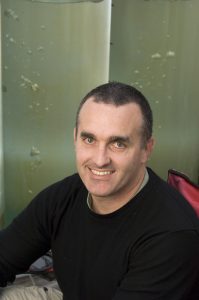Dr. Christopher Reddy To Receive the C.C. Patterson Award
– December 23, 2013
The Gulf of Mexico Research Initiative (GoMRI) congratulates one of its own, Christopher Reddy, on his selection for 2014 Clair C. Patterson Award.
The Geochemical Society recognizes one scientist a year who has led an innovative breakthrough of fundamental significance in environmental geochemistry, particularly in service to society.
A marine geochemist with the Woods Hole Oceanographic Institution (WHOI) and a co-Principal Investigator with the GoMRI-funded consortium Deepsea to Coast Connectivity in the Eastern Gulf of Mexico (Deep-C), Reddy studies the effects of environmental pollutants with emphasis on major oil spills.
He has gained a reputation as an “honest broker” on pollution-related issue, and his work provides “an unprecedented view of the compositional evolution of petroleum and a quantitative understanding of weathering processes that determine its fate in the ocean.”
GoMRI Research Board member John Farrington has known Reddy from his days as a graduate student to his current position and “still counts visits and conversations with Chris about science as highlights.” Farrington praises Reddy’s work from several perspectives: “He is an enthusiastic, innovative, hard-working researcher, adviser, and mentor to many students and postdocs, and an excellent communicator of science to the public. His contributions to environmental chemistry as noted in the citation for the Patterson Award have had enormous impact and will continue to do so for many years to come.” Peter Brewer, also a GoMRI Research Board member, noted that, “There are not many awards of this kind and it is good to see them go to fully deserving scientists.”
This award was created in honor of Clair C. Patterson who developed the method to calculate the age of Earth as 4.55 billion years old – a figure that remains the most accurate measurement today. Patterson also pioneered research on lead contamination and campaigned to ban lead in gasoline and food cans. “Clair C. Patterson was a tenacious trailblazer in studying lead and lead pollution. For me to be associated with him is, quite frankly, humbling,” Reddy says.
Reddy has been a pioneer in developing and applying advanced chromatographic and spectrometric techniques to identify the source, transport, and ultimate fate of petroleum hydrocarbons in the coastal and open ocean. “His application and development of innovative analytical approaches have resulted in a quantum leap in our ability to predict the persistence of anthropogenic and naturally occurring petroleum in the marine environment,” says Jeff Seewald, chair of WHOI’s Department of Marine Chemistry and Geochemistry.
“One of my overarching interests in studying oil spills is that there are compounds in oil that seem to persist a very long time while there are others that can disappear quickly. I find it fascinating that a spectrum like this exists,” Reddy says. “I am grateful to GoMRI and the Deep-C Consortium for support to study oil spills and the opportunity to collaborate with others I have not had the chance to work with in the past. The end result is that the last three years have been quite fruitful and a direct result of GoMRI funding.”
Parts of this announcement are from the original Woods Hole Oceanographic Institution press release.
To read an overview of the Deep-C project, click here. Click here for the Deep-C website.
The Gulf of Mexico Research Initiative (GoMRI) is a 10-year independent research program established to study the effect, and the potential associated impact, of hydrocarbon releases on the environment and public health, as well as to develop improved spill mitigation, oil detection, characterization and remediation technologies. An independent and academic 20-member Research Board makes the funding and research direction decisions to ensure the intellectual quality, effectiveness and academic independence of the GoMRI research. All research data, findings and publications will be made publicly available. The program was established through a $500 million financial commitment from BP. For more information, visit https://gulfresearchinitiative.org/.
© Copyright 2010- 2017 Gulf of Mexico Research Initiative (GoMRI) – All Rights Reserved. Redistribution is encouraged with acknowledgement to the Gulf of Mexico Research Initiative (GoMRI). Please credit images and/or videos as done in each article. Questions? Contact web-content editor Nilde “Maggie” Dannreuther, Northern Gulf Institute, Mississippi State University (maggied@ngi.msstate.edu).






